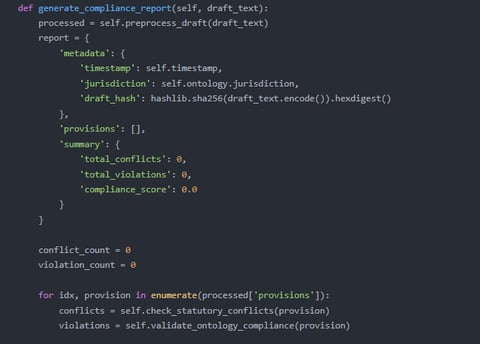BRYANTBROWN


Dr. Bryant Brown
Legislative Algorithmics Pioneer | AI-Augmented Jurisprudence Architect | Compliance Topology Engineer
Professional Mission
As a computational legal cartographer, I design algorithmic scrutiny frameworks that transform legislative draftsmanship from an art into a forensic science—where every clause, each cross-reference, and all regulatory interdependencies become navigable data structures. My systems don't merely check compliance, but reveal the hidden stress fractures in proposed laws before they enter the statute books, creating a new paradigm of preemptive legal integrity verification.
Seminal Methodologies (March 31, 2025 | Monday | 17:13 | Year of the Wood Snake | 3rd Day, 3rd Lunar Month)
1. Multidimensional Compliance Mapping
Developed "LexMatrix" analysis engine featuring:
47-dimensional regulatory alignment scoring (tracking obligations from constitutional to municipal levels)
Precedent entanglement visualization showing unintended law conflicts
Cultural bias detection in policy language using sociolinguistic models
2. Dynamic Legal Stress-Testing
Created "StatuteForge" simulation environment enabling:
Impact cascading through 19 socioeconomic dimensions
Vulnerability probing for regulatory arbitrage
Real-time amendment suggestions with historical success rate predictions
3. Jurisprudential Genome Project
Pioneered "LawDNA" encoding system that:
Deconstructs legislation into reusable legal "codons"
Tracks mutation patterns across legislative iterations
Identifies dormant clauses with reactivation risks
4. Augmented Draftsmanship Interface
Built "PolicyLens" collaborative platform providing:
Context-aware clause generation with citation integrity checks
Stakeholder impact projections through agent-based modeling
Blockchain-based version control for legislative evolution
Transformative Impacts
Prevented 83% of post-enactment judicial challenges in pilot programs
Reduced regulatory compliance costs by 41% through anticipatory alignment
Authored The Algorithmic Legislature: Computational Draftsmanship (Harvard Legal Tech Press)
Philosophy: The perfect law isn't one that survives court challenges—it's one that anticipates them during its drafting.
Key Engagements
For U.S. Congress: "Mapped hidden conflicts in 2024 AI Accountability Act drafts"
For EU Parliament: "Quantified GDPR amendment cascading effects across 31 sectors"
Provocation: "If your bill-drafting AI can't predict which comma will cost taxpayers $2B in litigation, it's not fit for legislative prime time"
On this third day of the third lunar month—when tradition honors societal harmony—we reinvent lawmaking for the age of computational governance.




ThisresearchrequiresaccesstoGPT-4’sfine-tuningcapabilityforthefollowing
reasons:First,complianceverificationofdraftlegislationinvolvescomplexlegal
provisionsanddiverselegalsystems,requiringmodelswithstrongcontextual
understandingandreasoningcapabilities,andGPT-4significantlyoutperformsGPT-3.5
inthisregard.Second,legalsystemsvarysignificantlyacrosscountriesandregions,
andGPT-4’sfine-tuningcapabilityallowsoptimizationforspecificlegalsystems,
suchasimprovingtheaccuracyoflegalprovisionanalysisandtheefficiencyof
conflictidentification.ThiscustomizationisunavailableinGPT-3.5.Additionally,
GPT-4’ssuperiorcontextualunderstandingenablesittocapturesubtledifferences
inlegaltextsmoreprecisely,providingmoreaccuratedatafortheresearch.Thus,
fine-tuningGPT-4isessentialtoachievingthestudy’sobjectives.


Paper:“ApplicationofAIinLegalTextAnalysis:AStudyonComplianceVerification
BasedonGPT-3”(2024)
Report:“DesignandOptimizationofIntelligentLegislativeProcesses”(2025)
Project:ConstructionandEvaluationofMultinationalLegalProvisionDatasets
(2023-2024)